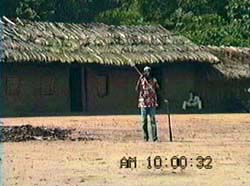| 3. Casting-talk I classified the styles of their utterances into four categories, along two standards: (1) the volume of the voice, “non-loud” or “loud;” and (2) “addressee-specified” or “addressee-unspecified.”
When they talk, they freely cross the boundaries of these four styles. For instance, when Japanese need to call people at a distance, they “switch their mind” first and then call. However, Bongando people's pronunciation is different; their voices shift in a continuous manner, from small to loud voice or from talking to specified persons to non specified persons.
Some of the time the bonango involved the transmission of information, but there were times when they talked about things about which Japanese might have difficulty understanding why there was a need to use a loud voice that could echo throughout the village:
Bonango is also sometimes transmitted through communication tools such as the drums and finger whistles. Messages such as “I am hungry”, or “it rains all the time these days” are sent through drum beats which can resonate for tens of kilometers. These drum beats are also known as bonango. When villagers hear them, they are at first alarmed and listen to the tone, wondering if it is information about somebody's death, for example. Then they say “oh, that's only bonango” and put down their guard when they realize that the content is really, for instance, what I described above
In sum, bonango is possible because, on one hand, speakers say all sorts of things they want to say, and on the other, other people do not take it seriously and do not pay attention. In other words, speakers know people will ignore them and thus are able to “cast away” their presentation irresponsibly. The listeners also understand this, so that they do not become seriously involved in what is being told. From this image, I named the style of utterance, “casting-talk.” KIMURA Daiji |

